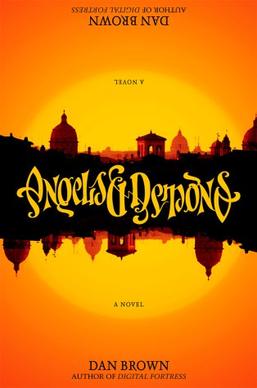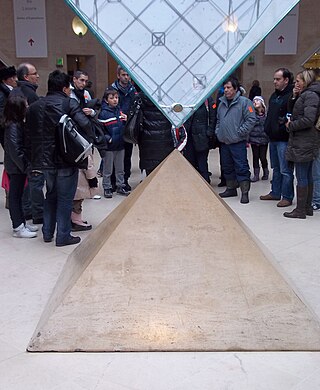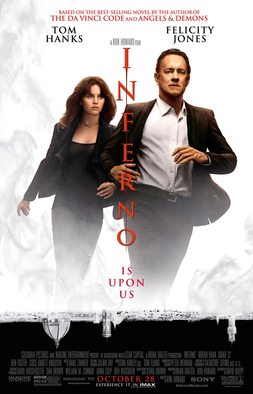
Daniel Gerhard Brown is an American author best known for his thriller novels, including the Robert Langdon novels Angels & Demons (2000), The Da Vinci Code (2003), The Lost Symbol (2009), Inferno (2013), and Origin (2017). His novels are treasure hunts that usually take place over a period of 24 hours. They feature recurring themes of cryptography, art, and conspiracy theories. His books have been translated into 57 languages and, as of 2012, have sold over 200 million copies. Three of them, Angels & Demons, The Da Vinci Code, and Inferno, have been adapted into films, while one of them, The Lost Symbol, was adapted into a television show.

Angels & Demons is a 2000 bestselling mystery-thriller novel written by American author Dan Brown and published by Pocket Books and then by Corgi Books. The novel introduces the character Robert Langdon, who recurs as the protagonist of Brown's subsequent novels. Angels & Demons shares many stylistic literary elements with its sequels, such as conspiracies of secret societies, a single-day time frame, and the Catholic Church. Ancient history, architecture, and symbology are also heavily referenced throughout the book. A film adaptation was released on May 15, 2009.

The Louvre Inverted Pyramid is a skylight constructed in the Carrousel du Louvre, an underground shopping mall in front of the Louvre Museum in France. It may be thought of as a smaller sibling of the more famous Louvre Pyramid proper, yet turned upside down: its upturned base is easily seen from outside.

The Da Vinci Code is a 2006 mystery thriller film directed by Ron Howard, written by Akiva Goldsman, and based on Dan Brown's 2003 novel of the same name. The first in the Robert Langdon film series, the film stars Tom Hanks, Audrey Tautou, Ian McKellen, Alfred Molina, Jürgen Prochnow, Jean Reno and Paul Bettany. In the film, Robert Langdon, a professor of religious symbology from Harvard University, is the prime suspect in the grisly and unusual murder of Louvre curator Jacques Saunière. On the body, the police find a disconcerting cipher and start an investigation. Langdon escapes with the assistance of police cryptologist Sophie Neveu, and they begin a quest for the legendary Holy Grail. A noted British Grail historian, Sir Leigh Teabing, tells them that the actual Holy Grail is explicitly encoded in Leonardo da Vinci's wall painting, The Last Supper. Also searching for the Grail is a secret cabal within Opus Dei, an actual prelature of the Holy See, who wish to keep the true Grail a secret to prevent the destruction of Christianity.

The Lost Symbol is a 2009 novel written by American writer Dan Brown. It is a thriller set in Washington, D.C., after the events of The Da Vinci Code, and relies on Freemasonry for both its recurring theme and its major characters.
Lynn Picknett is an English writer of books that are mainly about religious history and popular conspiracy theories, the paranormal, the occult, and historical mysteries.
The Da Vinci Code, a popular suspense novel by Dan Brown, generated criticism and controversy after its publication in 2003. Many of the complaints centered on the book's speculations and misrepresentations of core aspects of Christianity and the history of the Catholic Church. Additional criticisms were directed toward the book's inaccurate descriptions of European art, history, architecture, and geography.

Founded by Adam Weishaupt in Bavaria in 1776, the Illuminati have been referred to in popular culture, in books and comics, television and films, and games. A number of novelists, playwrights and composers are alleged to have been Illuminati members and to have reflected this in their work. Early conspiracy theories surrounding the Illuminati have inspired various creative works, and continue to do so.

The Da Vinci Code is a 2006 adventure puzzle video game developed by The Collective and published by 2K for PlayStation 2, Xbox and Microsoft Windows. Although the game was released on the same day that the film of the same name opened in theaters, it is based directly on the 2003 novel by Dan Brown rather than the film. As such, the characters in the game do not resemble nor sound like their filmic counterparts.

The Da Vinci Code is a 2003 mystery thriller novel by Dan Brown. It is Brown's second novel to include the character Robert Langdon: the first was his 2000 novel Angels & Demons. The Da Vinci Code follows symbologist Robert Langdon and cryptologist Sophie Neveu after a murder in the Louvre Museum in Paris causes them to become involved in a battle between the Priory of Sion and Opus Dei over the possibility of Jesus Christ and Mary Magdalene having had a child together.

Angels & Demons is a 2009 American mystery thriller film directed by Ron Howard and written by Akiva Goldsman and David Koepp, based on Dan Brown's 2000 novel of the same title. It is the sequel to the 2006 film The Da Vinci Code, also directed by Howard, and the second installment in the Robert Langdon film series. However, the novel version was published before The Da Vinci Code novel. Filming took place in Rome, Italy, and the Sony Pictures Studios in Culver City, California. Tom Hanks reprises his role as Professor Robert Langdon, while Ayelet Zurer stars as Dr. Vittoria Vetra, a CERN scientist joining Langdon in the quest to recover a missing vial of antimatter from a mysterious Illuminati terrorist. Producer Brian Grazer, composer Hans Zimmer and screenwriter Akiva Goldsman also return, with David Koepp coming on board to help the latter.
John Langdon is an American graphic designer, ambigram artist, painter, and writer. Langdon has been a freelance artist specializing in logos, type, and lettering since 1977. He retired from teaching in Drexel University's graphic design program in November 2015 after 27 years of service.

The Holy Blood and the Holy Grail is a book by Michael Baigent, Richard Leigh, and Henry Lincoln.

Inferno is a 2013 mystery thriller novel by American author Dan Brown and the fourth book in his Robert Langdon series, following Angels & Demons, The Da Vinci Code and The Lost Symbol. The book was published on May 14, 2013, ten years after publication of The Da Vinci Code (2003), by Doubleday. It was number one on the New York Times Best Seller list for hardcover fiction and Combined Print & E-book fiction for the first eleven weeks of its release, and also remained on the list of E-book fiction for the first seventeen weeks of its release. A film adaptation was released in the United States on October 28, 2016.

Inferno is a 2016 American action mystery thriller film directed by Ron Howard and written by David Koepp, loosely based on the 2013 novel of the same name by Dan Brown. It is the sequel to The Da Vinci Code (2006) and Angels & Demons (2009), and is the third and final film in the Robert Langdon film series. It stars Tom Hanks, reprising his role as Robert Langdon, alongside Felicity Jones as Dr. Sienna Brooks, Omar Sy, Sidse Babett Knudsen, Ben Foster, and Irrfan Khan.

The Robert Langdon franchise consists of American action-adventure mystery-thriller installments, including three theatrical films directed by Ron Howard, and a television series. The films, based on the novel series written by Dan Brown, center on the fictional character of Robert Langdon. Though based on the book series, the films have a different chronological order, consisting of: The Da Vinci Code (2006), Angels & Demons (2009) and Inferno (2016), all starring Tom Hanks as Langdon, alongside different ensemble casts. Despite mixed-to-negative critical reception, the films are considered box office successes, having a combined gross total of $1.5 billion worldwide.

The Robert Langdon book series is named after Robert Langdon, the protagonist of the novels by American author Dan Brown. Langdon is portrayed as a Harvard University professor of religious iconology and symbology, a fictional field related to the study of historic symbols, which is not methodologically connected to the actual discipline of semiotics. Brown's novels that feature the lead character also include historical themes and Christianity as motifs, and as a result have generated controversy. Brown states on his website that his books are not anti-Christian, and that he is on a "constant spiritual journey" himself.

Origin is a 2017 mystery thriller novel by American author Dan Brown and the fifth installment in his Robert Langdon series, following Inferno. The book was released on October 3, 2017, by Doubleday. The book is predominantly set in Spain and features minor sections in Sharjah and Budapest.
The Da Vinci Code is a play based on the 2003 mystery thriller novel of the same name by Dan Brown, adapted by Rachel Wagstaff and Duncan Abel.

Dan Brown's The Lost Symbol, or simply The Lost Symbol, is an American action-adventure mystery-thriller television series based on Dan Brown's 2009 novel The Lost Symbol. The series is a prequel to the Robert Langdon film series and features Ashley Zukerman as fictional Harvard symbologist Robert Langdon. It also stars Eddie Izzard, Beau Knapp, Rick Gonzalez, Valorie Curry and Sumalee Montano in main roles. Dan Trachtenberg directed the series pilot and serves as executive producer on the series alongside Ron Howard, Brian Grazer and Brown himself. The series consists of ten episodes, premiered on September 16, 2021, on Peacock. In January 2022, the series was cancelled after one season.
















